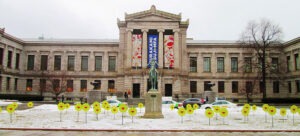As we move into spring and summer, I have to admit that I’m still vain enough to start obsessing about what I’m eating and what it’s doing to my size and shape. As an individual, I can (I can!) exert some control over what I ingest — and therefore how I look and feel.
But we nonprofits swallow stuff too (new programs without sufficient overhead, restricted donations, even whole buildings), often without recognizing how these things may change the way we look and act over time — how our intake of certain assets might inadvertently limit our agility, for instance, and our ability to participate in the activities we really want to be a part of.
Some of you may remember the image from the children’s book The Little Prince of the boa constrictor who ate an elephant and ended up looking like a man’s hat. The snake, as I recall, looked a bit stunned in that classic illustration. (Go look at it — it’s great!) This image is recalled in the attached article by Clara Miller, “Hidden in Plain Sight: Understanding Nonprofit Capital Structure,” and is used as a metaphor for the consequences of not paying enough attention to the design of your organization’s capital structure.
Sign up for our free newsletters
Subscribe to NPQ's newsletters to have our top stories delivered directly to your inbox.
By signing up, you agree to our privacy policy and terms of use, and to receive messages from NPQ and our partners.
As I write to you, the Spring 2003 issue is in the mail. I have to confess that this issue was one of my all-time favorites to work on because our working title for it was “The Oddities of Nonprofit Finances.” That title eventually got dumped by my editorial colleagues, but its spirit remained, and it was a relief to surface so much of what makes nonprofit financial management such an “alternate plane” experience for many of us — even those who are far from numbers-phobic. It seemed a particularly appropriate time to cover this topic because, with our funding environments in such turbulence, many managers will find themselves making financial decisions at a faster pace than usual. We wanted to help inform any decisions you and your boards might be making.
In that spirit, we’re also sending along a link to “Costs Are Cool: The Strategic Value of Economic Clarity,” by Susan Colby and Abigail Rubin at Bridgespan Group, which we strongly encourage you to read. Much as Clara’s piece illuminates the importance of capital structure, this article underscores the value of understanding the true costs of providing programs and services — and why this economic clarity is sometimes difficult to achieve.
And for a hard-numbers look at the current funding landscape, we’re including a link to the Foundation Center, whose review of 2002 foundation giving includes some indicators for where you might want to look for funds. But don’t be lulled by the overall message — that giving has remained relatively stable. Look to the subtext concerning where the money is coming from, and think about how you might want to augment your fundraising program.













